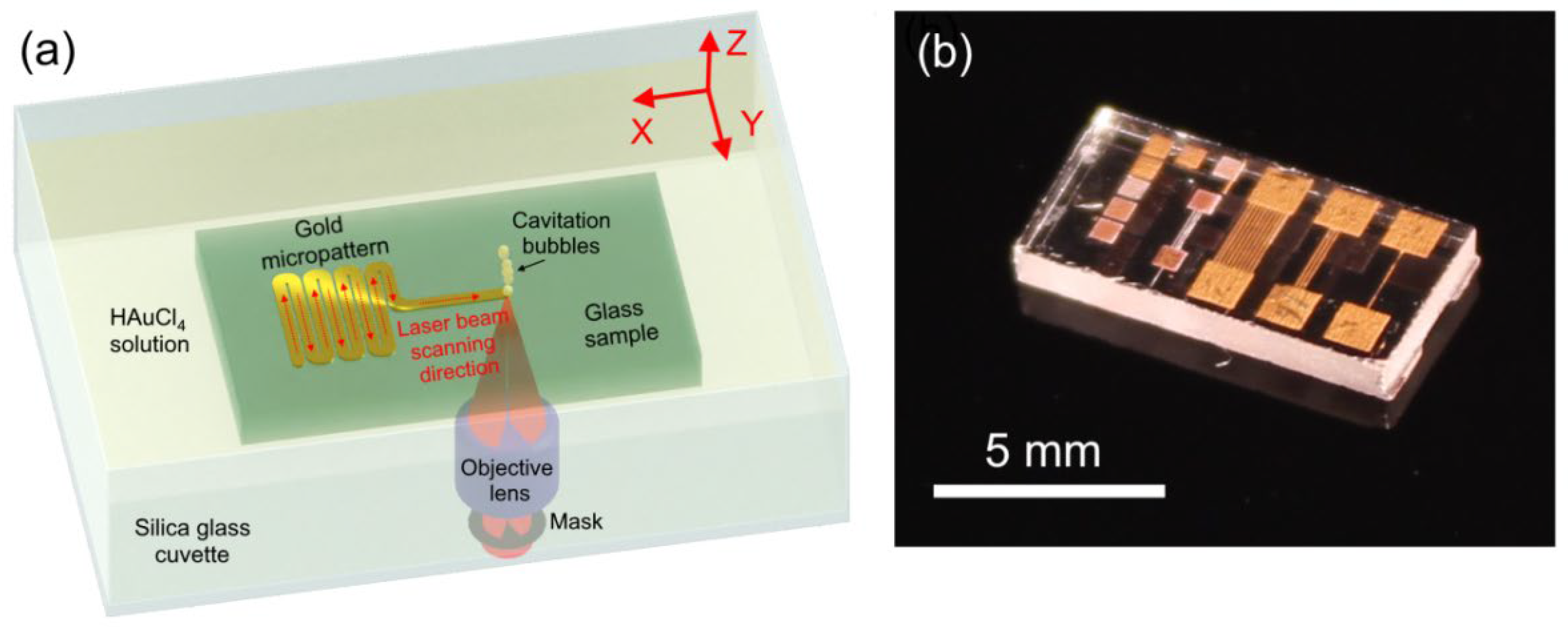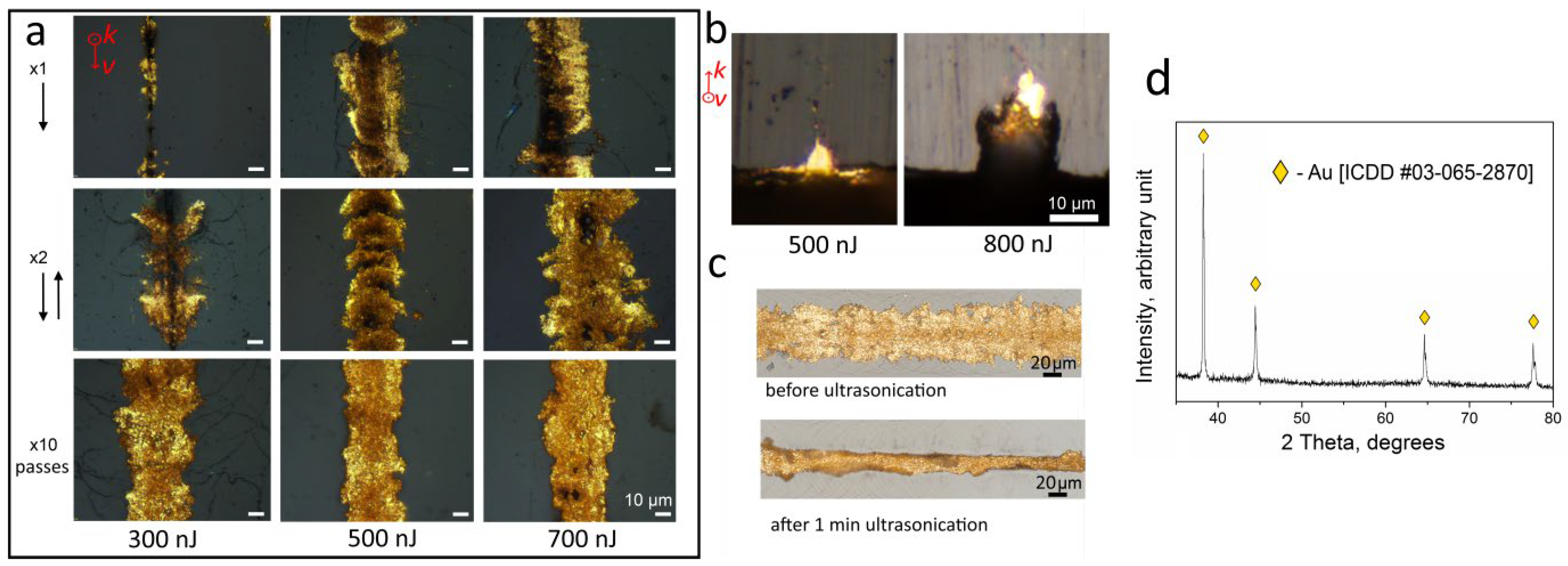One-Stage Femtosecond Laser-Assisted Deposition of Gold Micropatterns on Dielectric Substrate
Abstract
:1. Introduction
2. Materials and Methods
3. Results and Discussion
4. Conclusions
Author Contributions
Funding
Informed Consent Statement
Data Availability Statement
Acknowledgments
Conflicts of Interest
References
- Cheng, C.-W.; Chan, P.-F.; Dow, W.-P. Direct Copper Pattern Plating on Glass and Ceramic Substrates Using an Al-Doped ZnO as an Adhesive and Conducting Layer. J. Electrochem. Soc. 2017, 164, D687. [Google Scholar] [CrossRef]
- Abidov, A.; Kim, S.; Kim, Y.B.; Gomez-Solis, C. Rapid & Low-Cost Prototyping of Metallic Patterns in Limited Facilities Condition. J. Mater. Sci. Mater. Electron. 2018, 29, 14328–14334. [Google Scholar] [CrossRef]
- Mizoshiri, M.; Kondo, Y. Direct Writing of Two- and Three-Dimensional Cu-Based Microstructures by Femtosecond Laser Reductive Sintering of the Cu2O Nanospheres. Opt. Mater. Express 2019, 9, 2828–2837. [Google Scholar] [CrossRef]
- Kochemirovsky, V.A.; Skripkin, M.Y.; Tveryanovich, Y.S.; Mereshchenko, A.S.; Gorbunov, A.O.; Panov, M.S.; Tumkin, I.I.; Safonov, S.V. Laser-Induced Copper Deposition from Aqueous and Aqueous–Organic Solutions: State of the Art and Prospects of Research. Russ. Chem. Rev. 2015, 84, 1059. [Google Scholar] [CrossRef]
- Kim, H.G.; Park, M.S. Fast Fabrication of Conductive Copper Structure on Glass Material Using Laser-Induced Chemical Liquid Phase Deposition. Appl. Sci. 2021, 11, 8695. [Google Scholar] [CrossRef]
- Seo, J.M.; Kwon, K.K.; Song, K.Y.; Chu, C.N.; Ahn, S.H. Deposition of Durable Micro Copper Patterns into Glass by Combining Laser-Induced Backside Wet Etching and Laser-Induced Chemical Liquid Phase Deposition Methods. Materials 2020, 13, 2977. [Google Scholar] [CrossRef] [PubMed]
- Long, J.; Li, Y.; Eliceiri, M.H.; Lai, Q.; Wu, J.; Zhao, X.; Grigoropoulos, C.P.; Xie, X. In-Situ Enhanced Laser Absorption in Aqueous Transition Metal Salt Solution Enables High-Quality Backside Wet Etching of Optical Glass by near-Infrared Lasers. J. Mater. Process. Technol. 2022, 302, 117507. [Google Scholar] [CrossRef]
- Cui, M.; Huang, T.; Xiao, R. Rapid Fabrication of Conductive Copper Patterns on Glass by Femtosecond Laser-Induced Reduction. Appl. Surf. Sci. 2022, 588, 152915. [Google Scholar] [CrossRef]
- Xu, J.; Liao, Y.; Zeng, H.; Zhou, Z.; Sun, H.; Song, J.; Wang, X.; Cheng, Y.; Xu, Z.; Sugioka, K.; et al. Selective Metallization on Insulator Surfaces with Femtosecond Laser Pulses. Opt. Express 2007, 15, 12743–12748. [Google Scholar] [CrossRef] [PubMed]
- Ginet, P.; Montagne, K.; Akiyama, S.; Rajabpour, A.; Taniguchi, A.; Fujii, T.; Sakai, Y.; Kim, B.; Fourmy, D.; Volz, S. Towards Single Cell Heat Shock Response by Accurate Control on Thermal Confinement with an On-Chip Microwire Electrode. Lab Chip 2011, 11, 1513–1520. [Google Scholar] [CrossRef] [PubMed]
- Khairullina, E.M.; Panov, M.S.; Andriianov, V.S.; Ratautas, K.; Tumkin, I.I.; Račiukaitis, G. High Rate Fabrication of Copper and Copper-Gold Electrodes by Laser-Induced Selective Electroless Plating for Enzyme-Free Glucose Sensing. RSC Adv. 2021, 11, 19521–19530. [Google Scholar] [CrossRef] [PubMed]
- Zhou, L.; Poggesi, S.; Bariani, G.C.; Mittapalli, R.; Adam, P.M.; Manzano, M.; Ionescu, R.E. Robust SERS Platforms Based on Annealed Gold Nanostructures Formed on Ultrafine Glass Substrates for Various (Bio)Applications. Biosensors 2019, 9, 53. [Google Scholar] [CrossRef] [PubMed] [Green Version]
- Song, J.; Liao, Y.; Liu, C.; Lin, D.; Qiao, L.; Cheng, Y.; Sugioka, K.; Midorikawa, K.; Zhang, S. Fabrication of Gold Microelectrodes on a Glass Substrate by Femtosecond-Laser-Assisted Electroless Plating. JLMN-J. Laser Micro/Nanoeng. 2012, 7, 334. [Google Scholar] [CrossRef] [Green Version]
- Li, R.Z.; Peng, R.; Kihm, K.D.; Bai, S.; Bridges, D.; Tumuluri, U.; Wu, Z.; Zhang, T.; Compagnini, G.; Feng, Z.; et al. High-Rate in-Plane Micro-Supercapacitors Scribed onto Photo Paper Using: In Situ Femtolaser-Reduced Graphene Oxide/Au Nanoparticle Microelectrodes. Energy Environ. Sci. 2016, 9, 1458–1467. [Google Scholar] [CrossRef]
- Lee, M.R.; Lee, H.K.; Yang, Y.; Koh, C.S.L.; Lay, C.L.; Lee, Y.H.; Phang, I.Y.; Ling, X.Y. Direct Metal Writing and Precise Positioning of Gold Nanoparticles within Microfluidic Channels for SERS Sensing of Gaseous Analytes. ACS Appl. Mater. Interfaces 2017, 9, 39584–39593. [Google Scholar] [CrossRef] [PubMed]
- Lapointe, J.; Kashyap, R. A Simple Technique to Overcome Self-Focusing, Filamentation, Supercontinuum Generation, Aberrations, Depth Dependence and Waveguide Interface Roughness Using Fs Laser Processing. Sci. Rep. 2017, 7, 499. [Google Scholar] [CrossRef] [PubMed]
- Huang, Y.; Xie, X.; Cui, J.; Zhou, W.; Chen, J.; Long, J. Robust Metallic Micropatterns Fabricated on Quartz Glass Surfaces by Femtosecond Laser-induced Selective Metallization. Opt. Express 2022, 3, 19544–19556. [Google Scholar] [CrossRef]
- Broadhead, E.J.; Tibbetts, K.M. Fabrication of Gold–Silicon Nanostructured Surfaces with Reactive Laser Ablation in Liquid. Langmuir 2020, 36, 10120–10129. [Google Scholar] [CrossRef] [PubMed]



Publisher’s Note: MDPI stays neutral with regard to jurisdictional claims in published maps and institutional affiliations. |
© 2022 by the authors. Licensee MDPI, Basel, Switzerland. This article is an open access article distributed under the terms and conditions of the Creative Commons Attribution (CC BY) license (https://creativecommons.org/licenses/by/4.0/).
Share and Cite
Lipateva, T.; Lipatiev, A.; Lotarev, S.; Shakhgildyan, G.; Fedotov, S.; Sigaev, V. One-Stage Femtosecond Laser-Assisted Deposition of Gold Micropatterns on Dielectric Substrate. Materials 2022, 15, 6867. https://doi.org/10.3390/ma15196867
Lipateva T, Lipatiev A, Lotarev S, Shakhgildyan G, Fedotov S, Sigaev V. One-Stage Femtosecond Laser-Assisted Deposition of Gold Micropatterns on Dielectric Substrate. Materials. 2022; 15(19):6867. https://doi.org/10.3390/ma15196867
Chicago/Turabian StyleLipateva, Tatiana, Alexey Lipatiev, Sergey Lotarev, Georgiy Shakhgildyan, Sergey Fedotov, and Vladimir Sigaev. 2022. "One-Stage Femtosecond Laser-Assisted Deposition of Gold Micropatterns on Dielectric Substrate" Materials 15, no. 19: 6867. https://doi.org/10.3390/ma15196867





